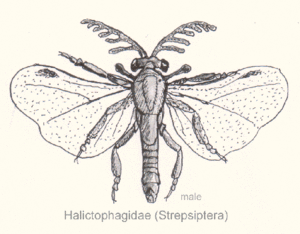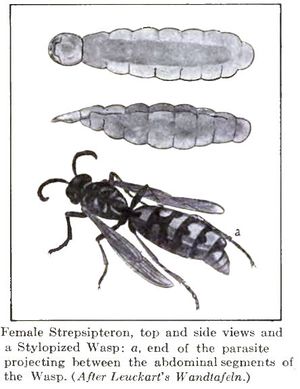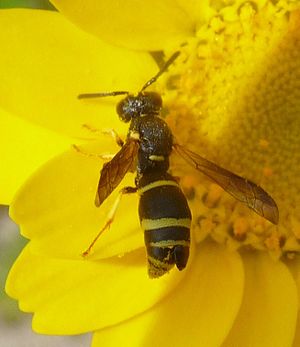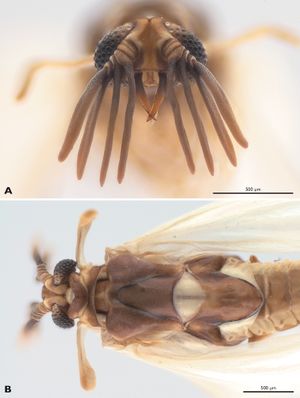ملتويات الأجنحة
| Strepsiptera | |
|---|---|

| |
| ذكر | |

| |
| التصنيف العلمي | |
| أصنوفة غير معروفة (أصلحها): | Strepsiptera |
| الفصائل | |
|
Bahiaxenidae | |
ملتويات الأجنحة Strepsiptera هي من رتبة endopterygote في الحشرات وتضم تسع فصائل (عائلات) مازالت موجودة تضم نحو 600 نوع موصوف. They are endoparasites in other insects, such as bees, wasps, leafhoppers, silverfish, and cockroaches. Females of most species never emerge from the host after entering its body, finally dying inside it. The early-stage larvae do emerge because they must find an unoccupied living host, and the short-lived males must emerge to seek a receptive female in her host.[1]
The order is not well known to non-specialists, and the nearest they have to a common name is "stylops".[2] The name of the order translates to "twisted wing"', giving rise to another name used for the order, twisted-wing insects.[3]
المنظر وعلم الأحياء
Males of the Strepsiptera have wings, legs, eyes, and antennae, though their mouthparts cannot be used for feeding. Many have mouthparts modified into sensory structures. To the uninitiated the males superficially look like flies. Adult males are very short-lived, usually surviving less than five hours, and do not feed. Females, in all families except the Mengenillidae, are not known to leave their hosts and are neotenic in form, lacking wings, legs, and eyes. Virgin females release a pheromone which the males use to locate them.
In the Stylopidia, the female's anterior region protrudes out of the host body and the male mates by rupturing the female's brood canal opening, which lies between the head and prothorax. Sperm passes through the opening in a process termed hypodermic insemination.[1] The offspring consume their mother from the inside in a process known as hemocelous viviparity. Each female then produces many thousands of triungulin larvae that emerge from the brood opening on the head, which protrudes outside the host body. These larvae have legs and actively search out new hosts. Their legs are partly vestigial in that they lack a trochanter, the leg segment that forms the articulation between the basal coxa and the femur).[4]
Strepsiptera of various species have been documented to attack hosts in many orders, including members of the orders Zygentoma, Orthoptera, Blattodea, Mantodea, Heteroptera, Hymenoptera, and Diptera. In the strepsipteran family Myrmecolacidae, the males parasitize ants, while the females parasitize Orthoptera.[1]
Strepsiptera eggs hatch inside the female, and the planidium larvae can move around freely within the female's haemocoel; this behavior is unique to these insects. The larvae escape through the female's brood canal, which communicates with the outside world.[5] The larvae are very active, because they only have a limited amount of time to find a host before they exhaust their food reserves. These first-instar larvae have stemmata (simple, single-lens eyes). When the larvae latch onto a host, they enter it by secreting enzymes that soften the cuticle, usually in the abdominal region of the host. Some species have been reported to enter the eggs of hosts.[بحاجة لمصدر] Larvae of Stichotrema dallatorreanurn Hofeneder from Papua New Guinea were found to enter their orthopteran host's tarsus (foot).[6] Once inside the host, they undergo hypermetamorphosis and become a less-mobile, legless larval form. They induce the host to produce a bag-like structure inside which they feed and grow. This structure, made from host tissue, protects them from the immune defences of the host. Larvae go through four more instars, and in each moult the older cuticle separates but is not discarded ("apolysis without ecdysis"), so multiple layers form around the larvae.[7] Male larvae pupate after the last moult, but females directly become neotenous adults.[8][9] The colour and shape of the host's abdomen may be changed and the host usually becomes sterile. The parasites then undergo pupation to become adults. Adult males emerge from the host bodies, while females stay inside. Females may occupy up to 90% of the abdominal volume of their hosts.[1]
Adult male Strepsiptera have eyes unlike those of any other insect, resembling the schizochroal eyes found in the trilobite group known as the Phacopina. Instead of a compound eye consisting of hundreds to thousands of ommatidia, that each produce a pixel of the entire image - the strepsipteran eyes consist of only a few dozen "eyelets" that each produce a complete image. These eyelets are separated by cuticle and/or setae, giving the cluster eye as a whole a blackberry-like appearance.[1][10]
Very rarely, multiple females may live within a single stylopized host; multiple males within a single host are somewhat more common. Adult males are rarely observed, however, although specimens may be lured using cages containing virgin females. Nocturnal specimens can also be collected at light traps.[1]
Strepsiptera of the family Myrmecolacidae can cause their ant hosts to linger on the tips of grass leaves, increasing the chance of being found by the parasite's males (in case of females) and putting them in a good position for male emergence (in case of males).[11]
التصنيف
The order, named by William Kirby in 1813,[12] is named for the hind wings, which are held at a twisted angle when at rest (from Greek στρέϕειν (strephein), to twist; and πτερόν (pteron), wing).[13] The fore wings are reduced to halteres (and initially were thought to be dried and twisted); this inspired the order name; Strepsiptera literally is the Greek plural for "twisted winged".

Strepsiptera were once believed to be the sister group to the beetle families Meloidae and Ripiphoridae, which have similar parasitic development and forewing reduction; early molecular research suggested their inclusion as a sister group to the flies,[1] in a clade called the halteria,[14] which have one pair of the wings modified into halteres,[15] and failed to support their relationship to the beetles.[15] Further molecular studies, however, suggested they are outside the clade Mecopterida (containing the Diptera and Lepidoptera), but found no strong evidence for affinity with any other extant group.[16] Study of their evolutionary position has been problematic due to difficulties in phylogenetic analysis arising from long branch attraction.[17] The most basal strepsipteran is the fossil Protoxenos janzeni discovered in Baltic amber,[18] while the most basal living strepsipteran is Bahiaxenos relictus, the sole member of the family Bahiaxenidae.[19] The earliest known strepsipteran fossil is that of Cretostylops engeli, discovered in middle Cretaceous amber from Myanmar.[20]
In 2012, a fresh molecular study revived the assertion that the Stepsiptera are the sister group of the Coleoptera (beetles).[21]

الفصائل
The Strepsiptera have two major groups: the Stylopidia and Mengenillidia. The Mengenillidia include three extinct families (Cretostylopidae, Protoxenidae, and Mengeidae) plus two extant families (Bahiaxenidae and Mengenillidae; the latter is not monophyletic, however.[19]) They are considered more primitive, and the known females (Mengenillidae only) are free-living, with rudimentary legs and antennae. The females have a single genital opening. The males have strong mandibles, a distinct labrum, and more than five antennal segments.[1]
The other group, the Stylopidia, includes seven families: the Corioxenidae, Halictophagidae, Callipharixenidae, Bohartillidae, Elenchidae, Myrmecolacidae, and Stylopidae. All Stylopidia have endoparasitic females having multiple genital openings.[1]
The Stylopidae have four-segmented tarsi and four- to six-segmented antennae, with the third segment having a lateral process. The family Stylopidae may be paraphyletic.[1] The Elenchidae have two-segmented tarsi and four-segmented antennae, with the third segment having a lateral process. The Halictophagidae have three-segmented tarsi and seven-segmented antennae, with lateral processes from the third and fourth segments.[4] The Stylopidae mostly parasitize wasps and bees, the Elenchidae are known to parasitize Fulgoroidea, while the Halictophagidae are found on leafhoppers, treehoppers, and mole cricket hosts.[4]
Strepsipteran insects in the genus Xenos parasitize Polistes carnifex, a species of social wasps.[22] These obligate parasites infect the developing wasp larvae in the nest and are present within the abdomens of female wasps when they hatch out. Here they remain until they thrust through the cuticle and pupate (males) or release infective first-instar larvae onto flowers (females). These larvae are transported back to their nests by foraging wasps.[23]
|
| |||||||||||||||||||||||||||||||||||||||||||||||||||||||||||||||
| Suggested phylogenetic position of the
Strepsiptera.[24] |
الاستخدامات
Some insects which have been considered as pests may have strepsipteran endoparasites. Inoculation of a pest population with the corresponding parasitoid may sometimes aid in reducing the impact of such pests, although no strepsipterans have ever been tested for use in this capacity, let alone being available for such purposes, either commercially or experimentally. In India the species Halictophagus palmae was first described as a new species in 2000, and in the original description the authors mused about the possible future uses of their discovery. A 2011 book later mentioned these musings.[25]
انظر أيضاً
المراجع
- ^ أ ب ت ث ج ح خ د ذ ر Whiting, M. F (2003). "Strepsiptera". In Resh, V. H.; R. T. Cardé (eds.). Encyclopedia of Insects. Academic Press. pp. 1094–1096.
- ^ Merriam-Webster: stylops broadly: an insect of the order Strepsiptera |[1]
- ^ Pierce, W. Dwight (1909). A monographic revision of the twisted winged insects comprising the order Strepsiptera Kirby. Washington: US Government.
- ^ أ ب ت Borror, D.J.; Triplehorn, C.A.; Johnson, N.F. (1989). Introduction to the Study of Insects (6 ed.). Brooks Cole.
- ^ Piper, Ross (2007), Extraordinary Animals: An Encyclopedia of Curious and Unusual Animals, Greenwood Press.
- ^ Kathirithamby, Jeyaraney (2001). "Stand tall and they still get you in your Achilles foot-pad". Proceedings of the Royal Society of London B: Biological Sciences. 268 (1483): 2287–2289. doi:10.1098/rspb.2001.1810. PMC 1088878. PMID 11703867.
- ^ Kathirithamby, Jeyaraney; Ross, Larry D.; Johnston, J. Spencer (2003). "Masquerading as Self? Endoparasitic Strepsiptera (Insecta) Enclose Themselves in Host-Derived Epidermal Bag". Proceedings of the National Academy of Sciences of the United States of America. 100 (13): 7655–7659. doi:10.1073/pnas.1131999100. PMC 164643. PMID 12788973.
- ^ Beani, Laura (2006). "Crazy wasps: when parasites manipulate the Polistes phenotype" (PDF). Annales Zoologici Fennici. 43: 564–574.
- ^ Kathirithamby, J (2000). "Morphology of the female Myrmecolacidae (Strepsiptera) including the apron, and an associated structure analogous to the peritrophic matrix". Zoological Journal of the Linnean Society. 128: 269–287. doi:10.1111/j.1096-3642.2000.tb00164.x.
- ^ Buschbeck, E. K.; B. Ehmer; R. R. Hoy (2003). "The unusual visual system of the Strepsiptera: external eye and neuropils" (PDF). Journal of Comparative Physiology A. 189: 617–630. doi:10.1007/s00359-003-0443-x.
- ^ Wojcik, Daniel P. (1989). "Behavioral Interactions between Ants and Their Parasites". The Florida Entomologist. 72 (1): 43–51. doi:10.2307/3494966. ISSN 0015-4040. JSTOR 3494966.
- ^ Pierce, William Dwight (1909). A monographic revision of the twisted winged insects comprising the order Strepsiptera Kirby. p. 209.
- ^ Kathirithamby, Jeyaraney (2002). "Strepsiptera". The Tree of Life Web Project. Archived from the original on July 15, 2017.
- ^ Whiting, Michael F. (1998). "Long-Branch Distraction and the Strepsiptera" (PDF). Systematic Biology. 47 (1): 134–138. doi:10.1080/106351598261076. Archived from the original (PDF) on 2006-09-01.
- ^ أ ب Whiting, Michael F.; Carpenter, James C.; Wheeler, Quentin D.; Wheeler, Ward C. (1997). "The Stresiptera Problem: Phylogeny of the Holometabolous Insect Orders Inferred from 18S and 28S Ribosomal DNA Sequences and Morphology". Systematic Biology. 46 (1): 1–68. doi:10.2307/2413635.
- ^ Bonneton, F.; Brunet, F. G.; Kathirithamby, J.; Laudet, V. (2006). "The rapid divergence of the ecdysone receptor is a synapomorphy for Mecopterida that clarifies the Strepsiptera problem". Insect Molecular Biology. 15 (3): 351–362. doi:10.1111/j.1365-2583.2006.00654.x. PMID 16756554.
- ^ Huelsenbeck, John P (1998). "Systematic Bias in Phylogenetic Analysis: Is the Strepsiptera Problem Solved?". Systematic Biology. 47 (3): 519–537. JSTOR 2585257. PMID 12066692.
- ^ Pohl, H.; Beutel, R.G.; Kinzelbach, R. (2005). "Protoxenidae fam. nov. (Insecta, Strepsiptera) from Baltic amber—a 'missing link' in strepsipteran phylogeny". Zoologica Scripta. 34: 57–69. doi:10.1111/j.1463-6409.2005.00173.x.
- ^ أ ب Bravo, Pohl; Silva-Neto; Beutel (2009). "Bahiaxenidae, a "living fossil" and a new family of Strepsiptera (Hexapoda) discovered in Brazil". Cladistics. 25: 614–623. doi:10.1111/j.1096-0031.2009.00264.x.
- ^ Grimaldi, D.; Kathirithamby, J.; Schawaroch, V. (2005). "Strepsiptera and triungula in Cretaceous amber". Insect Systematics & Evolution. 36: 1–20. doi:10.1163/187631205788912787.
- ^ Niehuis, O.; Hartig, G.; Grath, S.; Pohl, H.; Lehmann, J.; Tafer, H.; Donath, A.; Krauss, V.; Eisenhardt, C.; Hertel, J.; Petersen, M.; Mayer, C.; Meusemann, K.; Peters, R.S.; Stadler, P.F.; Beutel, R.G.; Bornberg-Bauer, E.; McKenna, D.D.; Misof, B. (2012). "Genomic and Morphological Evidence Converge to Resolve the Enigma of Strepsiptera". Current Biology. 22 (14): 1309–1313. doi:10.1016/j.cub.2012.05.018. PMID 22704986.
- ^ Kathirithamby, Jeyaraney; Hughes, David (2006). "Description and biological notes of the first species of Xenos (Strepsiptera: Stylopidae) parasitic in Polistes carnifex F. (Hymenoptera: Vespidae) in Mexico". Zootaxa. 1104: 35–45.
- ^ Hughes, D. P.; Beani, L.; Turillazzi, S.; Kathirithamby, J. (2003). "Prevalence of the parasite Strepsiptera in Polistes as detected by dissection of immatures". Insectes Sociaux. 50 (1): 62–68. doi:10.1007/s000400300010.
- ^ Kathirithamby, Jeyaraney. 2002. Strepsiptera. Twisted-wing parasites. Version 24 September 2002. [2] in The Tree of Life Web Project
- ^ Venkateswarlu, B.; Shanker, Arun; Shanker, Chitra; Maheswari, M. (Nov 22, 2011). Crop Stress and its Management: Perspectives and Strategies. Springer Science & Business Media. p. 104. ISBN 9400722192.
للاستزادة
- Grimaldi, D. and Engel, M.S. (2005). Evolution of the Insects. Cambridge University Press. ISBN 0-521-82149-5.
{{cite book}}: CS1 maint: multiple names: authors list (link)
وصلات خارجية
- Strepsiptera in Baltic amber (www.amber-inclusions.dk) - Strepsiptera, Mengeidae, Mengea tertiaria
- http://tolweb.org/tree?group=Strepsiptera
- Survey of Modern Counterparts of Schizochroal Trilobite Eyes: Structural and Functional Similarities and Differences
- Family outline: Strepsiptera
- The Peculiar Strepsiptera Life Cycle



